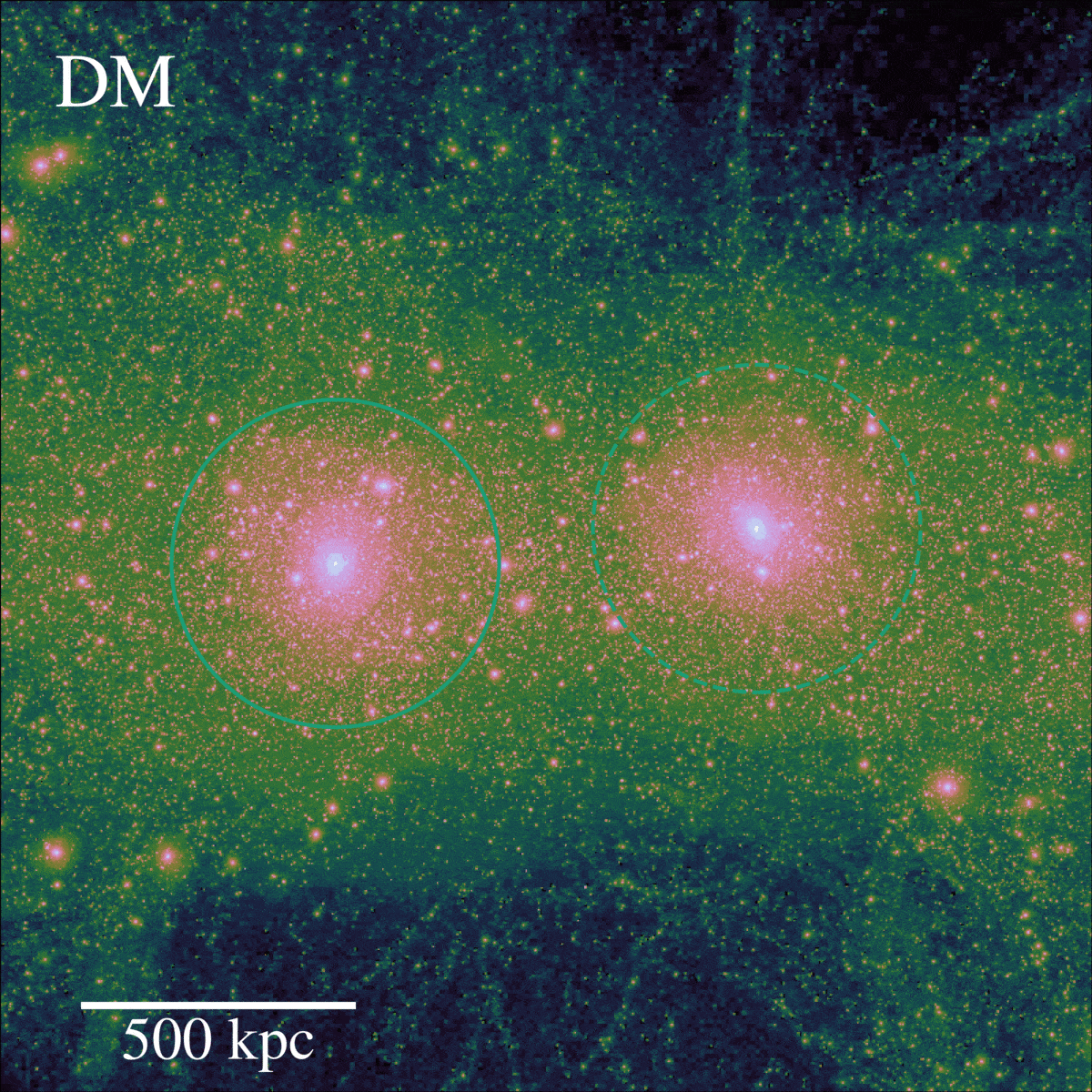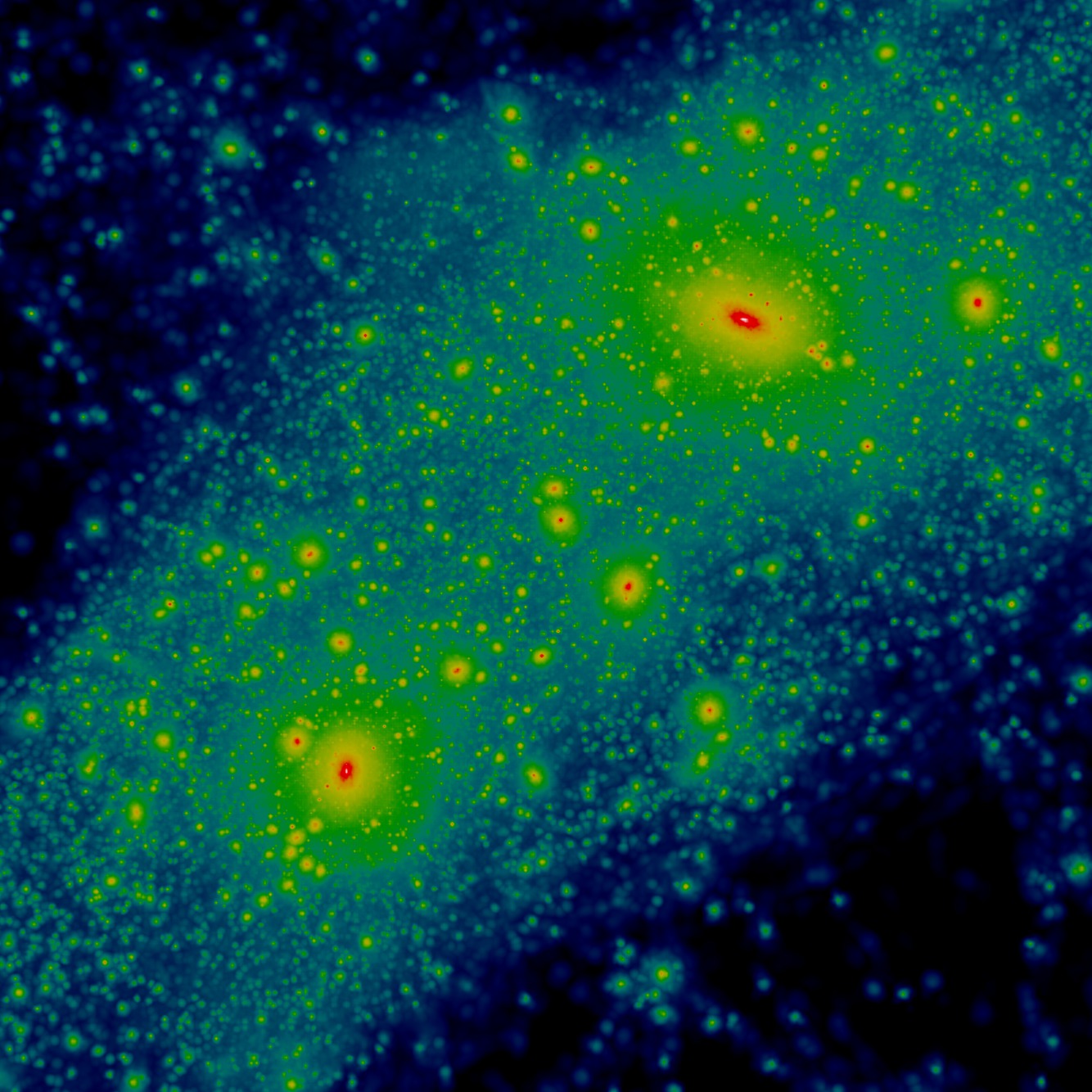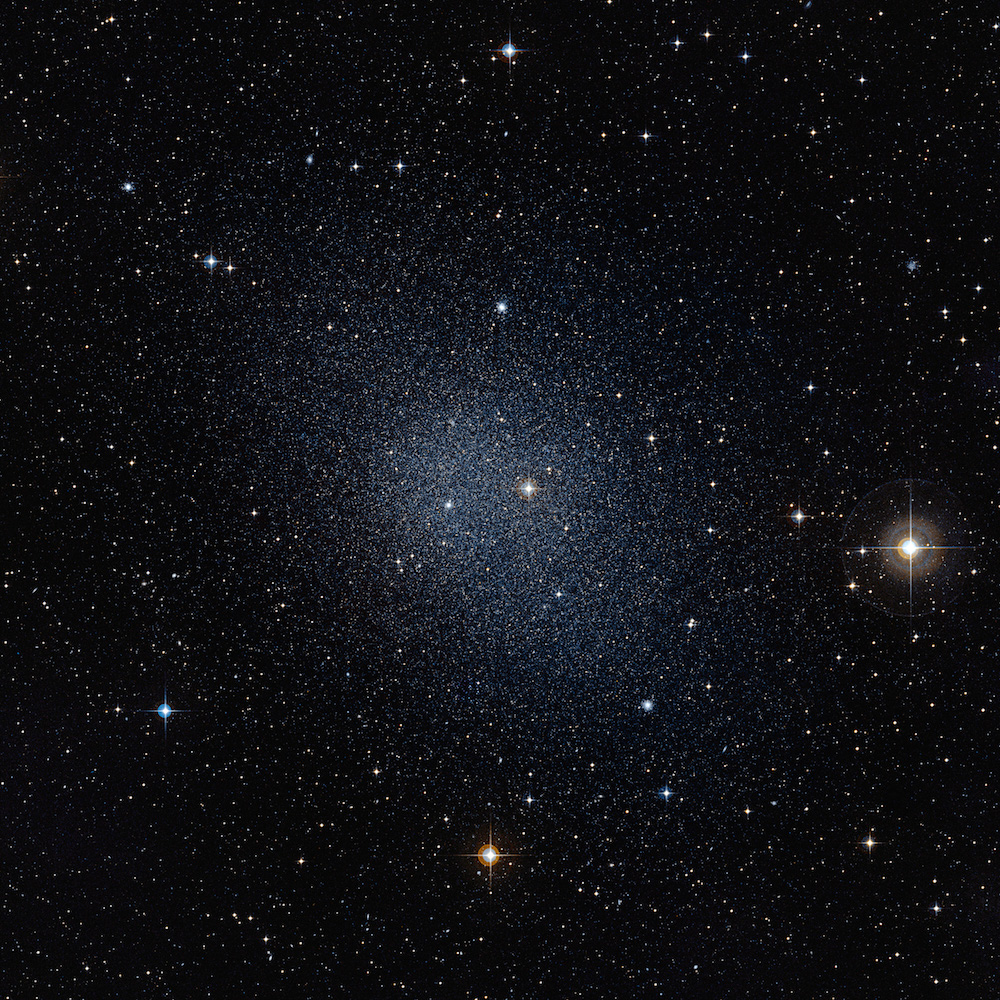Research
I primarily explore how the Local Group, together with numerical simulations, can inform galaxy formation theory. Most recently, I have begun working with the FIRE (Feedback in Realistic Environments) collaboration to include hydrodyanmics, star formation, and stellar/supernova feedback in cosmological simulations of the Local Group.
A large set of movies illustrating the evolution of Milky Way-mass galaxies in the FIRE simulations are available here.
A similar set of movies for the recently completed ELVIS on FIRE suite is in progress.

ELVIS on FIRE
ELVIS on FIRE applies the FIRE models for star formation, feedback, etc. to environments that are designed to mimic the real Local Group, with analogues to both the Milky Way and Andromeda. The FIRE physics yield dwarf galaxy populations that match observations both in terms of the number and internal structure of dwarf galaxies around the Milky Way. The image above cycles between the 3D dark matter, stellar, and gas density in one simulation.

ELVIS
The publicly available Exploring the Local Volume in Simulations (ELVIS) suite, consisting of 12 Local Group-like halo pairs and 24 mass-matched isolated halos, allows for a statistical understanding of the LG and its history, and provides the basis for predictions regarding future observations. ELVIS has enabled over forty publications since its inception, and continues to provide an ideal laboratory for exploring ΛCDM predictions for structure in the Local Group.

Dwarf Galaxies
Dwarfs are the most dark matter dominated objects in the Universe, and they are crucial for understanding the particle nature of dark matter, the earliest epochs of galaxy formation, the aftermath of reionization, and much more. Their abundances, internal structures, total masses, star formation histories, metallicities, and phase-space distributions around the Milky Way and Andromeda galaxies all provide stringent tests of ΛCDM. (Image credit: ESO DSS-2)
Publications
First Author Publications
-
The Local Group on FIRE: dwarf galaxy populations across a suite of hydrodynamic simulations
Shea Garrison-Kimmel, Philip F. Hopkins, Andrew Wetzel, James S. Bullock, Michael Boylan-Kolchin, Dušan Kereš, Claude-André Faucher-Giguère, Kareem El-Badry, Astrid Lamberts, and Eliot Quataert (2019), MNRAS, 487, 1380-1399 -
Star formation histories of dwarf galaxies in the FIRE simulations: dependence on mass and Local Group environment
Shea Garrison-Kimmel, Andrew Wetzel, Phillip F. Hopkins, Robyn Sanderson, Kareem El-Badry, Andrew Graus, T. K. Chan, Robert Feldmann, Michael Boylan-Kolchin, and Christopher Hayward, submitted to MNRAS -
The origin of the diverse morphologies and kinematics of Milky Way-mass galaxies in the FIRE-2 simulations
Shea Garrison-Kimmel, Philip F. Hopkins, Andrew Wetzel, Kareem El-Badry, Robyn E. Sanderson, James S. Bullock, Xiangcheng Ma, Freeke van de Voort, Zachary Hafen, and Claude-André Faucher-Giguère (2018), MNRAS, 481, 4133-4157 -
Not so lumpy after all: modelling the depletion of dark matter subhaloes by Milky Way-like galaxies
Shea Garrison-Kimmel, Andrew Wetzel, James S. Bullock, Philip F. Hopkins, Michael Boylan-Kolchin, Claude-André Faucher-Giguère, Dušan Kereš, Eliot Quataert, Robyn E. Sanderson, and Andrew S. Graus (2017), MNRAS, 471, 1709-1727 -
Organized chaos: scatter in the relation between stellar mass and halo mass in small galaxies
Shea Garrison-Kimmel, James S. Bullock, Michael Boylan-Kolchin, and Emma Bardwell (2017), MNRAS, 464, 3108-3120 -
Running with BICEP2: implications for small-scale problems in CDM
Shea Garrison-Kimmel, Shunsaku Horiuchi, Kevork N. Abazajian, James S. Bullock, and Manoj Kaplinghat (2014), MNRAS, 444, 961-970 -
Too big to fail in the Local Group
Shea Garrison-Kimmel, Michael Boylan-Kolchin, James S. Bullock, and Evan N. Kirby (2014), MNRAS, 444, 222-236 -
ELVIS: Exploring the Local Volume in Simulations
Shea Garrison-Kimmel, Michael Boylan-Kolchin, James S. Bullock, and Kyle Lee (2014), MNRAS, 438, 2578-2596 -
Can feedback solve the too-big-to-fail problem?
Shea Garrison-Kimmel, Miguel Rocha, Michael Boylan-Kolchin, James S. Bullock, and Jaspreet Lally (2013), MNRAS, 433, 3539-3546
Nth Author Publications
-
Formation, vertex deviation, and age of the Milky Way's bulge: input from a cosmological simulation with a late-forming bar
Victor P. Debattista, Oscar A. Gonzalez, Robyn E. Sand erson, Kareem El-Badry, Shea Garrison-Kimmel, Andrew Wetzel, Claude-André Faucher-Giguère, and Philip F. Hopkins (2019), MNRAS, 485, 5073-5085 -
Characterizing the Infall Times and Quenching Timescales of Milky Way Satellites with Gaia Proper Motions
Sean P. Fillingham, Michael C. Cooper, Tyler Kelley, M. K. Rodriguez Wimberly, Michael Boylan-Kolchin, James S. Bullock, Shea Garrison-Kimmel, Marcel S. Pawlowski, and Coral Wheeler, submitted to MNRAS -
Phat ELVIS: The inevitable effect of the Milky Way's disc on its dark matter subhaloes
Tyler Kelley, James S. Bullock, Shea Garrison-Kimmel, Michael Boylan-Kolchin, Marcel S. Pawlowski, and Andrew S. Graus (2019), MNRAS, in press -
But What About... Cosmic Rays, Magnetic Fields, Conduction, & Viscosity in Galaxy Formation
Philip F. Hopkins, T. K. Chan, Shea Garrison-Kimmel, Suoqing Ji, Kung-Yi Su, Cameron B. Hummels, Dusan Keres, Eliot Quataert, and Claude-Andre Faucher-Giguere, submitted to MNRAS -
A profile in FIRE: resolving the radial distributions of satellite galaxies in the Local Group with simulations
Jenna Samuel, Andrew Wetzel, Erik Tollerud, Shea Garrison-Kimmel, Sarah Loebman, Kareem El-Badry, Philip F. Hopkins, Michael Boylan-Kolchin, Claude-Andre Faucher-Giguere, and James S. Bullock, submitted to MNRAS -
Warm FIRE: simulating galaxy formation with resonant sterile neutrino dark matter
Brandon Bozek, Alex Fitts, Michael Boylan-Kolchin, Shea Garrison-Kimmel, Kevork Abazajian, James S. Bullock, Dušan Kereš, Claude-André Faucher-Giguère, Andrew Wetzel, and Robert Feldmann (2019), MNRAS, 483, 4086-4099 -
The suppression of star formation on the smallest scales: what role does environment play?
M. K. Rodriguez Wimberly, M. C. Cooper, S. P. Fillingham, M. Boylan-Kolchin, J. S. Bullock, and S. Garrison-Kimmel (2019), MNRAS, 483, 4031-4039 -
The Suppression of Star Formation on the Smallest Scales: What Role Does Environment Play?
M. K. Rodriguez Wimberly, M. C. Cooper, S. P. Fillingham, M. Boylan-Kolchin, J. S. Bullock, and S. Garrison-Kimmel (2018), MNRAS, in press -
Be it therefore resolved: Cosmological Simulations of Dwarf Galaxies with Extreme Resolution
Coral Wheeler, Philip F. Hopkins, Andrew B. Pace, Shea Garrison-Kimmel, Michael Boylan-Kolchin, Andrew Wetzel, James S. Bullock, Dusan Keres, Claude-Andre Faucher-Giguere, and Eliot Quataert, submitted to MNRAS -
Reconciling Observed and Simulated Stellar Halo Masses
Robyn E. Sanderson, Shea Garrison-Kimmel, Andrew Wetzel, Tsang Keung Chan, Philip F. Hopkins, Dušan Kereš, Ivanna Escala, Claude-André Faucher-Giguère, and Xiangcheng Ma (2018), ApJ, 869, 12 -
The Origins of the Circumgalactic Medium in the FIRE Simulations
Z. Hafen, C. -A. Faucher-Giguere, D. Angles-Alcazar, J. Stern, D. Keres, C. Hummels, C. Esmerian, S. Garrison-Kimmel, K. El-Badry, and A. Wetzel, submitted to MNRAS -
Phat ELVIS: The inevitable effect of the Milky Way's disk on its dark matter subhaloes
Tyler Kelley, James S. Bullock, Shea Garrison-Kimmel, Michael Boylan-Kolchin, Marcel S. Pawlowski, and Andrew S. Graus, submitted to MNRAS -
Dwarf Galaxies in CDM, WDM, and SIDM: Disentangling Baryons and Dark Matter Physics
Alex Fitts, Michael Boylan-Kolchin, Brandon Bozek, James S. Bullock, Andrew Graus, Victor Robles, Philip F. Hopkins, Kareem El-Badry, Shea Garrison-Kimmel, and Claude-André Faucher-Giguère, submitted to MNRAS -
Predicting the binary black hole population of the Milky Way with cosmological simulations
A. Lamberts, S. Garrison-Kimmel, P. F. Hopkins, E. Quataert, J. S. Bullock, C. -A. Faucher-Giguère, A. Wetzel, D. Kereš, K. Drango, and R. E. Sand erson (2018), MNRAS, 480, 2704-2718 -
Where are the most ancient stars in the Milky Way?
Kareem El-Badry, Joss Bland-Hawthorn, Andrew Wetzel, Eliot Quataert, Daniel R. Weisz, Michael Boylan-Kolchin, Philip F. Hopkins, Claude-André Faucher-Giguère, Dušan Kereš, and Shea Garrison-Kimmel (2018), MNRAS, 480, 652-668 -
FIRE-2 simulations: physics versus numerics in galaxy formation
Philip F. Hopkins, Andrew Wetzel, Dušan Kereš, Claude-André Faucher-Giguère, Eliot Quataert, Michael Boylan-Kolchin, Norman Murray, Christopher C. Hayward, Shea Garrison-Kimmel, and Cameron Hummels (2018), MNRAS, 480, 800-863 -
Under the Firelight: Stellar Tracers of the Local Dark Matter Velocity Distribution in the Milky Way
Lina Necib, Mariangela Lisanti, Shea Garrison-Kimmel, Andrew Wetzel, Robyn Sanderson, Philip F. Hopkins, Claude-André Faucher-Giguère, and Dušan Kereš, submitted to ApJ -
How low does it go? Too few Galactic satellites with standard reionization quenching
Andrew S. Graus, James S. Bullock, Tyler Kelley, Michael Boylan-Kolchin, Shea Garrison-Kimmel, and Yuewen Qi, submitted to MNRAS -
Simulating galaxies in the reionization era with FIRE-2: galaxy scaling relations, stellar mass functions, and luminosity functions
Xiangcheng Ma, Philip F. Hopkins, Shea Garrison-Kimmel, Claude-André Faucher-Giguère, Eliot Quataert, Michael Boylan-Kolchin, Christopher C. Hayward, Robert Feldmann, and Dušan Kereš (2018), MNRAS, 478, 1694-1715 -
Environmental quenching of low-mass field galaxies
Sean P. Fillingham, Michael C. Cooper, Michael Boylan-Kolchin, James S. Bullock, Shea Garrison-Kimmel, and Coral Wheeler (2018), MNRAS, 477, 4491-4498 -
The origin of ultra diffuse galaxies: stellar feedback and quenching
T. K. Chan, D. Kereš, A. Wetzel, P. F. Hopkins, C. -A. Faucher-Giguère, K. El-Badry, S. Garrison-Kimmel, and M. Boylan-Kolchin (2018), MNRAS, 478, 906-925 -
Simulating galaxies in the reionization era with FIRE-2: morphologies and sizes
Xiangcheng Ma, Philip F. Hopkins, Michael Boylan-Kolchin, Claude-André Faucher-Giguère, Eliot Quataert, Robert Feldmann, Shea Garrison-Kimmel, Christopher C. Hayward, Dušan Kereš, and Andrew Wetzel (2018), MNRAS, 477, 219-229 -
Modeling the Impact of Baryons on Subhalo Populations with Machine Learning
Ethan O. Nadler, Yao-Yuan Mao, Risa H. Wechsler, Shea Garrison-Kimmel, and Andrew Wetzel (2018), ApJ, 859, 129 -
Synthetic Gaia surveys from the FIRE cosmological simulations of Milky-Way-mass galaxies
Robyn E. Sanderson, Andrew Wetzel, Sarah Loebman, Sanjib Sharma, Philip F. Hopkins, Shea Garrison-Kimmel, Claude-André Faucher-Giguère, Dušan Kereš, and Eliot Quataert, submitted to ApJ -
Formation of globular cluster candidates in merging proto-galaxies at high redshift: a view from the FIRE cosmological simulations
Ji-hoon Kim, Xiangcheng Ma, Michael Y. Grudić, Philip F. Hopkins, Christopher C. Hayward, Andrew Wetzel, Claude-André Faucher-Giguère, Dušan Kereš, Shea Garrison-Kimmel, and Norman Murray (2018), MNRAS, 474, 4232-4244 -
A Testable Conspiracy: Simulating Baryonic Effects on Self-interacting Dark Matter Halos
Oliver D. Elbert, James S. Bullock, Manoj Kaplinghat, Shea Garrison-Kimmel, Andrew S. Graus, and Miguel Rocha (2018), ApJ, 853, 109 -
Under pressure: quenching star formation in low-mass satellite galaxies via stripping
Sean P. Fillingham, Michael C. Cooper, Andrew B. Pace, Michael Boylan-Kolchin, James S. Bullock, Shea Garrison-Kimmel, and Coral Wheeler (2016), MNRAS, 463, 1916-1928 -
When and where did GW150914 form?
A. Lamberts, S. Garrison-Kimmel, D. R. Clausen, and P. F. Hopkins (2016), MNRAS, 463, L31-L35 -
Resonant sterile neutrino dark matter in the local and high-z Universe
Brandon Bozek, Michael Boylan-Kolchin, Shunsaku Horiuchi, Shea Garrison-Kimmel, Kevork Abazajian, and James S. Bullock (2016), MNRAS, 459, 1489-1504 -
Properties of resonantly produced sterile neutrino dark matter subhaloes
Shunsaku Horiuchi, Brandon Bozek, Kevork N. Abazajian, Michael Boylan-Kolchin, James S. Bullock, Shea Garrison-Kimmel, and Jose Onorbe (2016), MNRAS, 456, 4346-4353 -
Taking care of business in a flash: constraining the time-scale for low-mass satellite quenching with ELVIS
Sean P. Fillingham, Michael C. Cooper, Coral Wheeler, Shea Garrison-Kimmel, Michael Boylan-Kolchin, and James S. Bullock (2015), MNRAS, 454, 2039-2049 -
Satellites of LMC-mass dwarfs: close friendships ruined by Milky Way mass haloes
A. J. Deason, A. R. Wetzel, S. Garrison-Kimmel, and V. Belokurov (2015), MNRAS, 453, 3568-3574 -
Sweating the small stuff: simulating dwarf galaxies, ultra-faint dwarf galaxies, and their own tiny satellites
Coral Wheeler, Jose Oñorbe, James S. Bullock, Michael Boylan-Kolchin, Oliver D. Elbert, Shea Garrison-Kimmel, Philip F. Hopkins, and Dušan Kereš (2015), MNRAS, 453, 1305-1316 -
Core formation in dwarf haloes with self-interacting dark matter: no fine-tuning necessary
Oliver D. Elbert, James S. Bullock, Shea Garrison-Kimmel, Miguel Rocha, Jose Oñorbe, and Annika H. G. Peter (2015), MNRAS, 453, 29-37 -
Satellite Dwarf Galaxies in a Hierarchical Universe: Infall Histories, Group Preprocessing, and Reionization
Andrew R. Wetzel, Alis J. Deason, and Shea Garrison-Kimmel (2015), ApJ, 807, 49 -
Cosmological simulations of decaying dark matter: implications for small-scale structure of dark matter haloes
Mei-Yu Wang, Annika H. G. Peter, Louis E. Strigari, Andrew R. Zentner, Bryan Arant, Shea Garrison-Kimmel, and Miguel Rocha (2014), MNRAS, 445, 614-629 -
Satellite Dwarf Galaxies in a Hierarchical Universe: The Prevalence of Dwarf-Dwarf Major Mergers
Alis Deason, Andrew Wetzel, and Shea Garrison-Kimmel (2014), ApJ, 794, 115 -
Near-field limits on the role of faint galaxies in cosmic reionization.
M. Boylan-Kolchin, J. S. Bullock, and S. Garrison-Kimmel (2014), MNRAS, 443, L44-L48 -
On the stark difference in satellite distributions around the Milky Way and Andromeda
Basilio Yniguez, Shea Garrison-Kimmel, Michael Boylan-Kolchin, and James S. Bullock (2014), MNRAS, 439, 73-82 -
The Stellar-to-halo Mass Relation for Local Group Galaxies
C. B. Brook, A. Di Cintio, A. Knebe, S. Gottlöber, Y. Hoffman, G. Yepes, and S. Garrison-Kimmel (2014), ApJ, 784, L14 -
Sterile neutrino dark matter bounds from galaxies of the Local Group
Shunsaku Horiuchi, Philip J. Humphrey, Jose Oñorbe, Kevork N. Abazajian, Manoj Kaplinghat, and Shea Garrison-Kimmel (2014), Phys. Rev. D, 89, 025017 -
How to zoom: bias, contamination and Lagrange volumes in multimass cosmological simulations
Jose Oñorbe, Shea Garrison-Kimmel, Ariyeh H. Maller, James S. Bullock, Miguel Rocha, and Oliver Hahn (2014), MNRAS, 437, 1894-1908 -
Cosmological simulations with self-interacting dark matter - I. Constant-density cores and substructure
Miguel Rocha, Annika H. G. Peter, James S. Bullock, Manoj Kaplinghat, Shea Garrison-Kimmel, Jose Oñorbe, and Leonidas A. Moustakas (2013), MNRAS, 430, 81-104